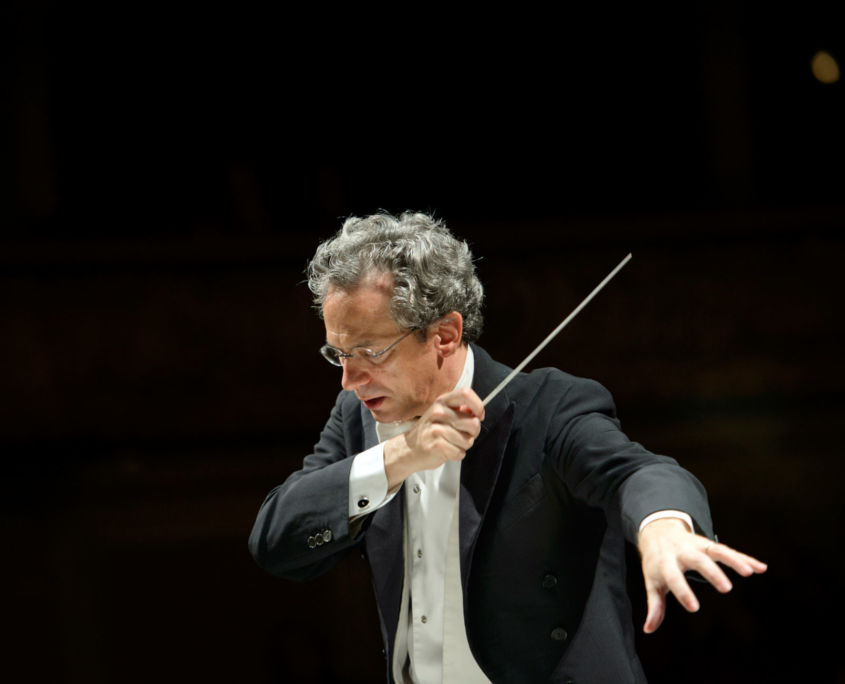A downsized chorus makes for a daring “Requiem” from Dallas Symphony

When the Dallas Symphony Orchestra performed Mozart’s Requiem on Thursday night at sold-out Meyerson Symphony Center, the sight of a masked, spread-out and less numerous Dallas Symphony Chorus was a reminder of the changes forced on live performance by Covid-19.
A prudent public health measure, trimming voices from an intensely vocal work also amounted to a daring artistic move. For the most part the risk paid off: Music director Fabio Luisi led a performance that was ultimately dramatic and satisfying. The audible challenges to balance and overall texture posed by a smaller chorus were made up for by moments of artistic brilliance.
Written by a dying Wolfgang Amadeus Mozart and finished in secrecy by a former student of his (whose version was performed on Thursday), Requiem enjoys a legend heightened by conspiracy, controversy and the sheer magnitude of its musical appeal. A financially strapped Mozart welcomed the commission from a recently widowed count. Whether or not he was also squarely confronting his own mortality, writing Requiem returned Mozart to what he called his “favorite form of composition,” with the liturgical text of the Mass giving way to the expression of his darker emotions in conjunction with his mastery of operatic techniques.
It is full of tension, this Requiem, with older Baroque signatures — harmonic refinements, bold formalism and Handelian counterpoint — merged into the new flowing lyricism of the Classical era. Mozart successfully brought church music into the dramatic space of serious opera.
Employing full orchestral forces and and a sturdy quartet of guest vocal soloists, Luisi — with his own operatic acumen — did well to convey the drama and theater of this work. His emphasis on tone color highlighted well the psychological and emotional states that shift the drama throughout the piece. Though some tempos were rushed, the orchestra maintained its composure, and the chorus — prepared by director Joshua Habermann — matched the instrumentalists in cohesion and energy.
Hushed, reverential brooding characterized the mood and delivery, with sparkling climaxes and harsh austerity interposed throughout. Notable passages include the Requiem aeternam, Lacrymosa, and the ever popular Dies irae.
The unfortunate reality of fewer numbers in the choral ranks, with singers masked and distanced, made for muddy diction and frequent imbalances in color. But the tenor section sang with notable tautness and clarity throughout. Basses and altos were most often lost under the tonal density in softer moments, but the grand tutti passages rang beautifully.
Soprano Kim-Lillian Strebel, mezzo-soprano Kelley O’Connor, tenor Spencer Lang, and bass David Leigh offered fine reads as the guest soloists, with O’Connor as a vocal standout in the quartet for her lusciousness of tone and attentiveness to balance.
Strauss’s Metamorphosen served as the program’s opener.
By the winter of 1944-45, the failure of Hitler’s attempt at European domination had become undeniable, and his fanatical, bitter-end resistance brought on an apocalyptic level of destruction that saw the razing of cultural monoliths across the continent. Theaters, opera houses, museums, and the like were utterly destroyed. For the Munich-born Richard Strauss, the implications of this violence and devastation ran deep: The institutions that fostered and cultivated his artistic development, and that of Mozart, Wagner, and his own father, were gone.
Metamorphosen, which was commissioned in July 1944 by the conductor of Zürich Collegium Paul Sacher and completed in April 1945, represented Strauss’ reflections on the tumult of the time — the decimation, rebirth, and transformation of culture. Scored for 23 strings, each with an identity of its own, it is a dense piece, rich in contrapuntal and polyphonic ruminations.
Luisi’s affinity for the Strauss literature gave this performance of the work poignant direction, marked by ample amounts of dynamic swell, with tastefully weighted heavy chord strikes and tender melodic line. The chamber ensemble’s balance was well met by the acoustic space of the Meyerson, as solo phrases passed between voices that always felt appropriately layered within the texture. Moments of dark moodiness opened beautifully to brighter harmonies with flowing tempo, highlighting the emotional, rather than intellectual, musical message.
The program repeats at 7:30 p.m. Saturday. dallassymphony.org